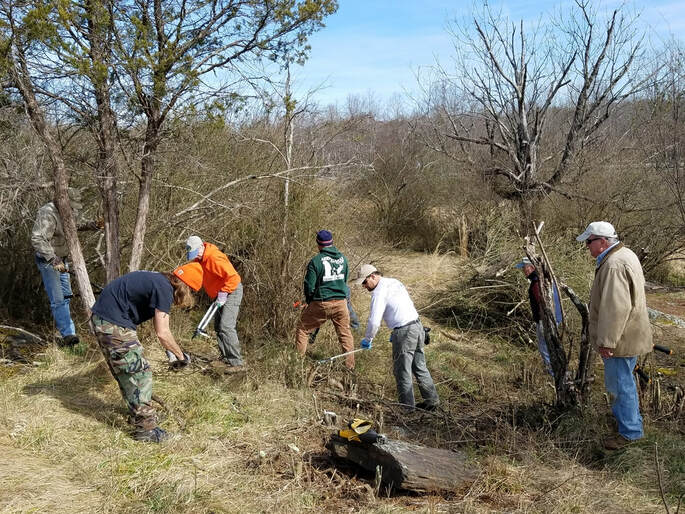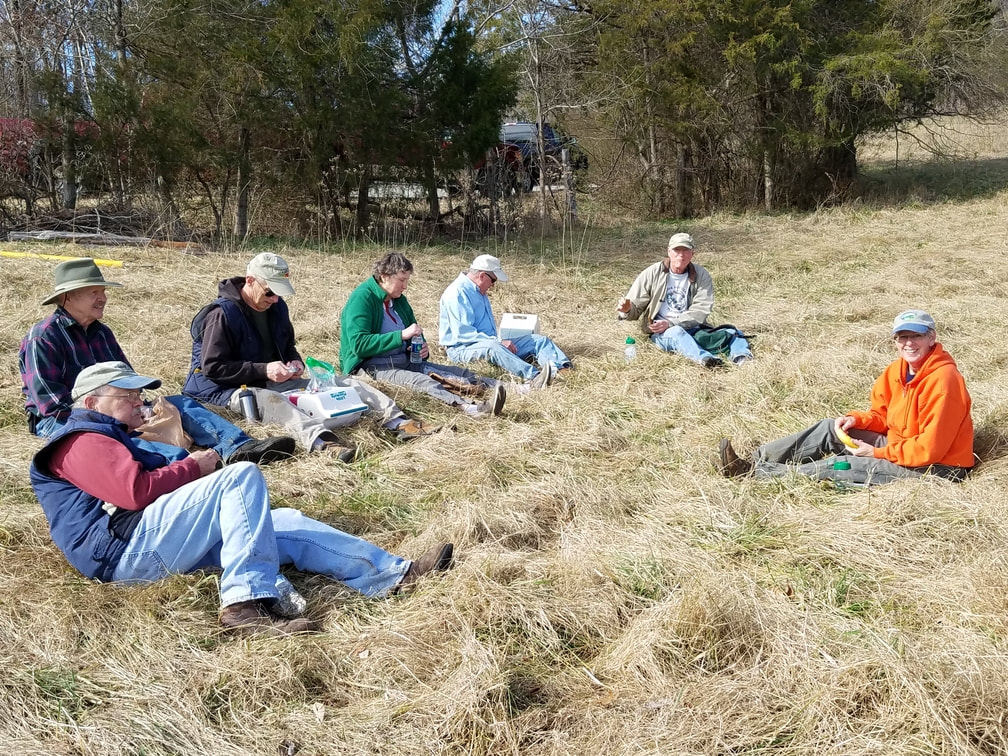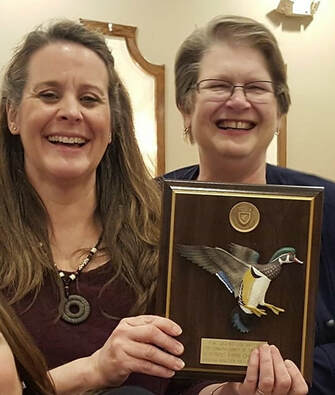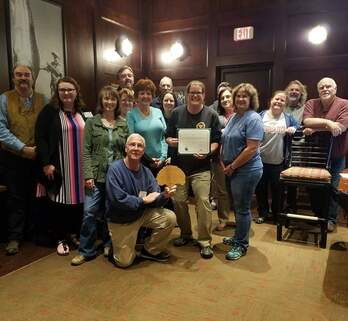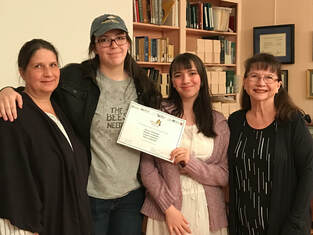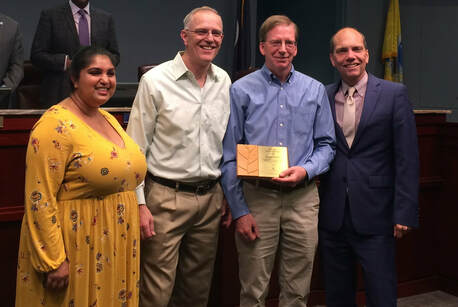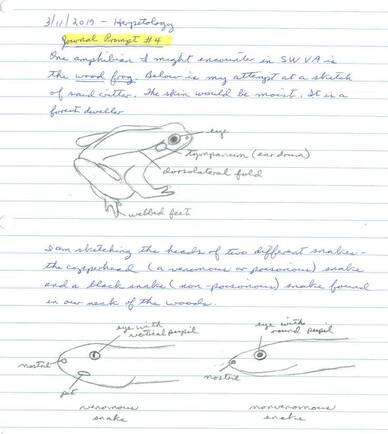 Like many of our chapters, the High Knob Chapter makes journaling part of their basic training course. They provide prompts to help trainees reflect upon the content they are learning. Image courtesy of Phil Meeks, VMN-High Knob Chapter Advisor and VCE Extension Agent in Wise County.
Like many of our chapters, the High Knob Chapter makes journaling part of their basic training course. They provide prompts to help trainees reflect upon the content they are learning. Image courtesy of Phil Meeks, VMN-High Knob Chapter Advisor and VCE Extension Agent in Wise County.
New VMN-High Knob Chapter Graduates and Naturalist RallySubmitted by Phil Meeks, VMN-High Knob Chapter Advisor and VCE Extension Agent in Wise County
The VMN-High Knob Chapter graduated 9 new volunteers from their basic training course in May. Loren Beha, Jordon & Rachel Blevins, Adam Boring, Elizabeth Cooperstein, Michael Henshaw, Lona Roberts, Cameo Smith and Colleen Turner. These men and women are from Big Stone Gap, Norton, Wise, Coeburn, Appalachia and Clintwood, and combined, they’ve already contributed 45 volunteer hours to citizen science, stewardship and environmental education in the area.
Also in May, the High Knob Chapter organized and hosted the first ever Pine Mountain Naturalist Rally. 50 nature enthusiasts came together near Pound, VA to learn about wildflowers, birds, butterflies, geology, and more.
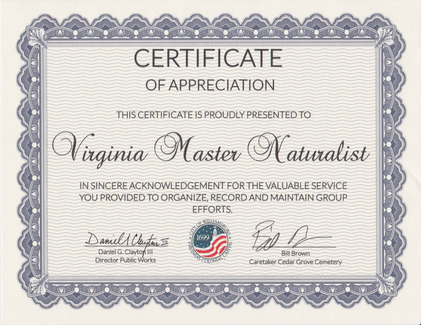
Historic Rivers Master Naturalists Recognized by the City of WilliamsburgSubmitted by Connie Reitz, VMN-Historic Rivers Chapter
July 22, 2019. It began like any other Monday at 2pm at Cedar Grove Cemetery in Williamsburg. Several members of the Historic Rivers Chapter of Virginia Master Naturalist gathered to check seven Eastern Bluebird (EABL) boxes. The cemetery caretaker, Bill Brown, was there, greeted everyone, and asked us to come over to box #3. It is not unusual to see Bill and we know of his particular interest in this box. However, a pleasant surprise was in store for this group of monitors. Bill presented a certificate of appreciation from the City of Williamsburg to the group for work done maintaining bluebird boxes and recording the activities of our feathered friends at the cemetery. Within an hour of this presentation a photo and acknowledgement of this recognition was on the City of Williamsburg Facebook page.
Rewind to 2017. EABL boxes were scattered throughout the cemetery from a previous William & Mary project. The boxes had not been monitored nor maintained for several years. HRC members David Lunt and Portia Belden worked with Bill Brown, Cedar Grove Cemetery caretaker, to install six new boxes. One old box—named a “legacy” box—was rescued with plans to rebuild it and return it to use at Cedar Grove. In 2017 the Cedar Grove EABL trail became an official project of the Historic Rivers Chapter. Seven Chapter members monitored the trail the inaugural year and documented active nests by EABL and Carolina Chickadees (CACH) with 17 bluebirds and ten chickadees fledging the first year.
The “legacy” box was added to the trail the next year and nine Chapter members were monitors. All but one box was productive the second year. The bluebirds and chickadees were joined by a tufted titmouse (TUTI) family. During this second year 32 EABLs, five CACHs, and five TUTIs fledged.
Press Live. This year has been a continuation of the progress from the first two years. Early in the season Bill brought another damaged “legacy” box to David asking if it could be restored and included on the trail. The box had been maintained for years by a close friend of Bill’s and he wanted this memory to be shared at the cemetery. This memory box became Box #3 on the trail and is located near the flag pole and Bill’s office/work building. Seeing this box filled with memories and sometimes bluebirds has brought a smile to his face every day.
The 2019 season has nine Chapter members as monitors. Jean Baluntanski, Portia Belden, Ginny Broome, Sherry Brubaker, Karen Grass, Nancy Greer, Barbara Neis, and Connie Reitz work with project leader David Lunt. Although two members are scheduled as leaders each week it is not unusual to have almost all of the team arrive for the weekly outing. To date, reporting information on the seven boxes on this trail has noted 31 EABL fledglings (with 4 nestlings still waiting to take the leap to the outside world), 4 CACH fledglings, and an exciting fledging of 4 Carolina Wrens. All seven of the boxes have been productive this season. Another “legacy” box was repaired and mounted mid-season bringing the total to eight boxes at the cemetery trail.
So, when you least expect it, someone is out there watching and appreciating the small things being done to care for our world. Someone is noticing what each of us is doing and slowly it becomes the norm. The rewards are smiles and sometimes a certificate. Thank you, Bill Brown and the City of Williamsburg. Members of the Historic Rivers Chapter will continue to work as citizen scientists, stewards, and educators to make our world a better place.
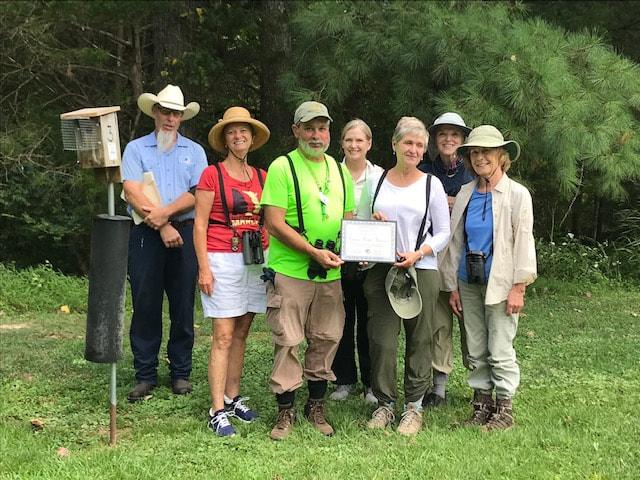
VMNs in the Historic Rivers Chapter monitor and maintain bluebird boxes at Cedar Grove Cemetery in Williamsburg. Photo by Tammy Rojek, City of Williamsburg Public Works Department.
Arlington Volunteers Recognized for Their ServiceSubmitted by Stephanie Martin, Arlington Regional Chapter Member
ship Chair
On July 23, Volunteer Arlington hosted “Arlington Cares: A Celebration of Volunteerism,” which recognized community volunteers who have served 100 hours or more within the past year. The event featured local nonprofit and county partners discussing their mission and volunteer opportunities.
The Arlington Regional Master Naturalist Chapter had 40 volunteers (listed below) with 100+ hours last year, and they were among those honored at the Arlington County event.
|
Alexander, Brooke
Bauder, Dick
Bowes, Lori
Browning, Bill
Chatham, Margaret
Dent, Honora
Durnan, Connie
Ellis, Nereide
Findikoglu, Patricia
Flynn, Dinah
Flynn, Marian
Frum, Jennifer
Genberg, Toni
George, Philip
Gottlieb, Joan
Gregory, Colt
Haffey, Joan
Hannigan, Noreen
Haynes, Caroline
Helget, Kasha
|
Howell, David
Hsu, YuHsin
Hurley, Jim
Hutton, Joanne
Jordan, Marion
Kim, Anna
Kiser, Beth
Klingelhofer, Phil
McLean, Mary
McNair, Ginny
Midboe, Eric
Miller, Eileen
Mullen, Carol
Nichols, David (Nick)
Olsen, Rodney
Palmatier, Nora
Roth, Susan
Tobin, Glenn
Werber, Ingrid
Young, Steve
|
Recognizing Mid-Year Milestone Achievements by VMN Volunteers
The VMN program recognizes volunteers who complete 250, 500, 1,000, 2,500, 5,000, 7,500, and 10,000 hours of service. These are cumulative volunteer hours starting when a volunteer joins the program. To offer some perspective, a volunteer who does the 40 hours of service annually to maintain status as a Certified Virginia Master Naturalist would take 6-7 years to achieve the 250 hour milestone and 125 years to achieve the 5,000 hour milestone!
Below, we have listed the volunteers who have achieved these milestones between January 2019 and July 2019 (based on reports received by our chapters as of July 30.) Some of these volunteers have demonstrated long-term dedication through many years with the program. Others have joined the program more recently, but they have done extraordinary levels of service in a short time frame. We are honored to have all of them sharing their time and talents as Virginia Master Naturalist volunteers.
|
250 Hours
William Boyd (Central Rappahannock Chapter)
William Hartzell (Central Rappahannock Chapter)
Judy Napier (Central Rappahannock Chapter)
Linda Bennett (Fairfax Chapter)
Judy Dority (Fairfax Chapter)
Allen (Michael) Hoffman (Fairfax Chapter)
Marilyn Kupetz (Fairfax Chapter)
Deborah Schram (Fairfax Chapter)
Carol Ely (Historic Rivers Chapter)
Roxanne Machamer (Historic Rivers Chapter)
Deena Obrokta (Historic Rivers Chapter)
Bill Vanzetta (Historic Rivers Chapter)
Glenda White (Historic Rivers Chapter)
Stephen Anderson (Historic Southside Chapter)
Jane Baur-Constant (Historic Southside Chapter)
Randy Dove (Historic Southside Chapter)
Henry McBurney (Historic Southside Chapter)
Sandy Oglesby (James River Chapter)
Valerie Pace (James River Chapter)
Candice Lowther (Merrimac Farm Chapter)
Clifford Pitts (Merrimac Farm Chapter)
Barry Buschow (Old Rag Chapter)
Ellen Early (Old Rag Chapter)
Sarah Bingham (Rivanna Chapter)
Katha Bollfrass (Rivanna Chapter)
Robert Finley (Rivanna Chapter)
Erin Johnson (Rivanna Chapter)
Beth Kuhn (Rivanna Chapter)
Roderick Walker (Rivanna Chapter)
Martha Weiss (Rivanna Chapter)
Elizabeth Bailie (Roanoke Valley Chapter)
Bob Peckman (Roanoke Valley Chapter)
Carol Rowlett (Roanoke Valley Chapter)
Karl Dydak (Shenandoah Chapter)
Debi Fischetti (Shenandoah Chapter)
Paul Guay (Shenandoah Chapter)
Dianne Krumme (Shenandoah Chapter)
Kelly Macoy (Shenandoah Chapter)
Zoe Sollenberger (Shenandoah Chapter)
Noel Boaz (Southwestern Piedmont Chapter)
Ellen Jessee (Southwestern Piedmont Chapter)
|
500 HoursSusan Sims (Banshee Reeks Chapter)Valerie Bertha (Fairfax Chapter)
Elisabeth Hoblitzell (Fairfax Chapter)
Kris Lansing (Fairfax Chapter)
Fred Siskind (Fairfax Chapter)
Debbie Walch (Fairfax Chapter)Chris Bowlen (Headwaters Chapter)Jean Balutanski (Historic Rivers Chapter)Rick Brown (Historic Rivers Chapter)
Barbara Bucklin (Historic Rivers Chapter)
James Corliss (Historic Rivers Chapter)
Renee Dallman (Historic Rivers Chapter)
Judy Kinshaw-Ellis (Historic Rivers Chapter)
Linda Morse (Historic Rivers Chapter)
Barbara Nall (Historic Southside Chapter)
Dera Cooper (Old Rag Chapter)
Phoebe Muenger (Old Rag Chapter)
Sandra Finley (Rivanna Chapter)Pat Klima (Rivanna Chapter)Karen Mulder (Rivanna Chapter)Leigh Surdukowski (Rivanna Chapter)Sara Dydak (Shenandoah Chapter)Janet Rigoni (Shenandoah Chapter)
1,000 Hours
Barbara Erlandson (Banshee Reeks Chapter)
Margaret Fisher (Fairfax Chapter)
Diana Handy (Fairfax Chapter)
Andy Sale (Headwaters Chapter)
Barbara Neis (Historic Rivers Chapter)
Connie Reitz (Historic Rivers Chapter)
Beverly Ruegsegger (Historic Southside Chapter)
Kim Cook (James River Chapter)
Diane Girgente (James River Chapter)
Douglas Dwoyer (Middle Peninsula Chapter)
Ed Tobias (Shenandoah Chapter)
2,500 Hours
Adrienne Frank (Historic Rivers Chapter)
|
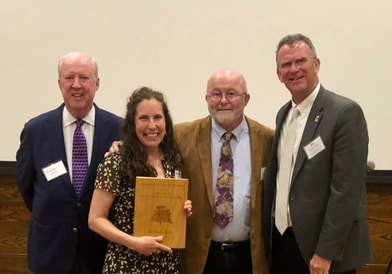 From left to right: Gerald P. McCarthy, Michelle Prysby, Mike Ellerbrock (Virginia Tech and Virginia Natural Resources Leadership Institute faculty), Ed Jones (Director, Virginia Cooperative Extension). Image by Virginia Natural Resources Leadership Institute staff.
From left to right: Gerald P. McCarthy, Michelle Prysby, Mike Ellerbrock (Virginia Tech and Virginia Natural Resources Leadership Institute faculty), Ed Jones (Director, Virginia Cooperative Extension). Image by Virginia Natural Resources Leadership Institute staff.
Michelle Prysby Recognized with the McCarthy Award
Michelle Prysby, VMN Program Director, received the 2019 Gerald P. McCarthy Award for Leadership in Environmental Conflict Resolution. The McCarthy Award is presented annually to an individual who demonstrates leadership in preserving and protecting the Commonwealth’s environment through collaboration.
Note from Michelle: I think the award really reflects the contributions of VMN volunteers across the state, as well as the efforts of VMN staff Terri Keffert and Tiffany Brown. Below are the remarks I gave at the award ceremony in June. I’m sharing them in case they might be useful in your own practice of working with and interacting with volunteers.
People who don’t work with volunteers are usually very surprised when I mention dealing with conflict within our volunteer groups. They can’t figure out what Master Naturalists would be having conflict about, and they almost always say “If they are unhappy, why don’t they just quit?”
It’s true, unlike many natural resource issues, no one’s financial livelihood, health, or property is at stake in the types of conflicts we typically see. But, dedicated volunteers can have an incredibly high level of passion for what they do, and they have a deep interest in the outcome of decisions that might seem unimportant to an outsider. Plus, the fact that they can just quit means the stakes are high for those organizations that depend on the their service.
So, I have found the VNRLI training and philosophies to be extremely relevant to working with volunteers.
I’d like to share just four strategies that I have found to be especially important when approaching volunteer conflicts.
First, do a lot of listening. Sometimes volunteers, like all people, just want to be heard, and they care about that much more than the outcome of the decision.
Second, be willing to not provide all the answers. Volunteers look to us as the program leaders to be the ultimate umpires and problem-solvers. It is my personal tendency to want to immediately offer solutions, but sometimes we have to turn their questions back to them and ask “What do you think would be fair? What do you think is the best solution?”
Third, encourage empathy and a belief in good intentions. I have found a lot of utility for myself in the compassion training technique that has you, when you feel wronged by someone else, repeat the mantra of “Just like me…” “Just like me, this person is seeking happiness. Just like me, this person is trying to reduce their suffering.” Along with being incredibly calming when someone cuts you off in traffic (“Just like me, he is trying to get to work on time…”), I think encouraging empathy can help our volunteers realize that their fellow volunteers, however frustrating, have good intentions.
Last, cultivate leadership skills. An amazingly wonderful yet terrifying aspect of our program is that all 30 of our local chapters are led and organized almost solely by volunteers, with just a bit of guidance from advisors with our state agencies. Every day, I am amazed and thankful that we have between 300 and 400 volunteers willing to take on board positions, and one of the most important things we do is support them. A few years ago, we instituted a new program called Leadership Days. All of those 300 plus board members of our volunteer chapters are invited, and the agendas are developed with their input. We find that more than 90% of attendees say that their participation in a Leadership Day makes them feel more effective in their roles, makes them feel more supported, and makes them more willing to continue serving in a leadership role.
It’s my hope and belief that all of these strategies together will lead to my ultimate goal – that volunteers will be confident and effective at working through conflicts themselves, and that they won’t need us!
If you haven’t worked with volunteers, but have the opportunity to do so, I encourage you to take the plunge. Your VNRLI training has prepared you well, and it can be one of the most rewarding things you ever do.
–Michelle D. Prysby, Virginia Master Naturalist Program Director and Extension Faculty, Virginia Tech Department of Forest Resources and Environmental Conservation
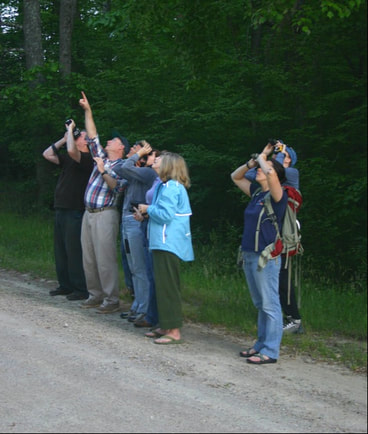 For DGIF’s Wildlife Viewing Plan, a wildlife viewer is someone who intentionally finds, observes, listens to, records, photographs, or interacts with wildlife or visits parks and natural areas because of wildlife. Photo by M. Prysby.
For DGIF’s Wildlife Viewing Plan, a wildlife viewer is someone who intentionally finds, observes, listens to, records, photographs, or interacts with wildlife or visits parks and natural areas because of wildlife. Photo by M. Prysby. 




